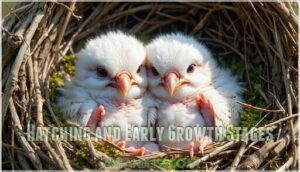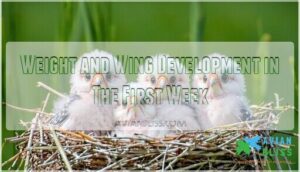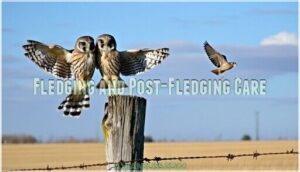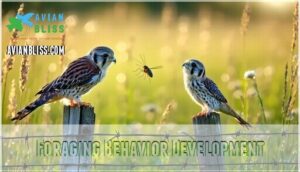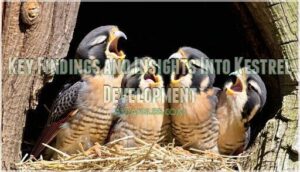This site is supported by our readers. We may earn a commission, at no cost to you, if you purchase through links.
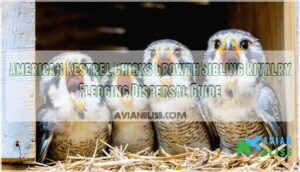
Weight triples by day seven while eyes open and pinfeathers emerge. Competition intensifies as chicks jostle for prime locations near parents’ beaks.
Fledging occurs at 28-31 days, launching juveniles into dispersal journeys averaging 15-20 kilometers from natal sites. Females usually travel farther than males, sometimes exceeding 1,000 kilometers. Understanding these patterns reveals fascinating survival strategies that determine which chicks master independence.
Table Of Contents
- Key Takeaways
- American Kestrel Chick Development
- Sibling Rivalry and Competition
- Fledging and Post-Fledging Care
- Dispersal Patterns and Challenges
- Age and Sex Identification
- Foraging Behavior Development
- Nesting Cycle and Migration Patterns
- American Kestrel Growth and Development Timeline
- Frequently Asked Questions (FAQs)
- How many American kestrel chicks have fledged?
- Are Kestrel chicks violent?
- How are Kestrel chicks differentiated?
- How do American kestrel chicks develop?
- How many American kestrel chicks hatched in 2024?
- When do American kestrel chicks leave the nest?
- How long does it take for kestrels to fledge?
- What is the migration pattern of the American kestrel?
- Are American Kestrels cavity nesters?
- How do you tell the age of an American kestrel?
- Conclusion
Key Takeaways
- You’ll witness dramatic transformation as kestrel chicks grow from 5-gram hatchlings to 90-120 gram fledglings in just four weeks, with their weight tripling by day seven alone.
- You’ll observe brutal sibling rivalry where stronger chicks dominate weaker ones during feeding, creating weight disparities of up to 20 grams and leading to siblicide in 2-5% of broods during food shortages.
- You’ll see fledging occur at 28-31 days old, followed by three weeks of intensive parental teaching where adults provide live prey practice and hunting demonstrations until juveniles achieve independence.
- You’ll track dispersal patterns showing females typically travel farther than males (sometimes over 1,000 kilometers versus males’ average 10 kilometers), with juveniles facing harsh survival challenges including unfamiliar predators, food scarcity, and territorial competition.
American Kestrel Chick Development
You’ll witness rapid transformation as American kestrel chicks grow from 5-gram hatchlings to 90-120 gram fledglings in just four weeks.
During this period, their weight triples by day seven while pinfeathers emerge and eyes open between days three and five.
Hatching and Early Growth Stages
Breaking free from their shells, American Kestrel chicks face immediate hatchling vulnerability. These nestlings weigh just 5-6 grams—their initial weight barely heavier than a nickel. Down development provides minimal insulation as hatchlings remain blind for days.
Within their first week, these extraordinary birds triple in weight, reaching 15-18 grams by day seven. This rapid transformation marks the beginning of pinfeather growth beneath their delicate skin, preparing them for future flight.
Pinfeathers and Eye Development
You’ll notice pinfeather emergence begins within days of hatching. These tiny feather buds push through the skin, gradually replacing the downy covering. Eye opening occurs between days 3-5, marking a key benchmark in sensory development. Early vision remains limited initially.
- Pinfeathers appear first on wing areas – sprouting through skin around day 3-4
- Eye opening happens gradually – one eye often opens before the other
- Chick pigmentation becomes visible – darker markings start showing through developing feathers
- Sensory development accelerates – nestlings begin responding to visual stimuli and movement
Weight and Wing Development in The First Week
You’ll witness notable changes as American Kestrel chicks growth accelerates during Week One. Hatchling Weight triples from initial 5-6 grams to 15-18 grams by day seven. This Growth Rate stems from constant Early Diet of insects and small mammals.
Feather Emergence begins as pinfeathers push through skin, replacing downy coverage. Primary feathers start developing beneath the surface while feather development progresses rapidly through intensive parental feeding.
Feeding Frequency and Brood Size Impact
Feeding schedules reveal vital insights about American Kestrel chicks’ survival odds. Brood Size directly impacts Feeding Rates and Parental Investment, creating Growth Disparities among siblings. Larger broods face reduced per-chick provisioning, intensifying Sibling Rivalry. Younger siblings experience physiological developmental stress due to this competition.
- Young chicks (0-7 days): Fed every 15-20 minutes for rapid growth
- Older chicks (7-14 days): Fed every 20-30 minutes as competition increases
- Pre-fledging stage (14-21 days): Fed every 30-60 minutes with larger prey
This feeding pattern affects Chick Survival rates and ultimately influences Fledging success and Dispersal readiness through targeted Parental Care strategies.
Sibling Rivalry and Competition
When you observe a kestrel nest with multiple chicks, you’ll notice fierce competition unfolds as siblings battle for survival in cramped quarters.
Studies show that larger, earlier-hatched chicks dominate feeding sessions, creating weight disparities of up to 20 grams between dominant and subordinate nestlings within the first two weeks.
Pecking Order and Begging Wars
After hatching, kestrel chicks establish a clear pecking order based on size and hatch timing. Chick dominance emerges quickly as larger siblings monopolize food resources. Begging intensity reaches extreme levels with ear-splitting shrieks competing for parental attention. This sibling rivalry creates significant food disparity between dominant and subordinate chicks.
The pecking order determines feeding priority, directly impacting survival rates through sibling competition and ongoing sibling disputes. Blue jays also exhibit this behavior, as they defend their territory during breeding season.
Siblicide and Hunger-Driven Competition
When food scarcity strikes, sibling competition escalates into life-or-death battles. Siblicide occurs in 2-5% of kestrel broods when hunger drives chick aggression beyond normal limits. This brood reduction mechanism helps guarantee at least some offspring survive resource shortages.
When food runs short, kestrel siblings turn deadly—nature’s harsh guarantee that someone survives
Key siblicide triggers include:
- High metabolic demands requiring 100+ daily feedings per chick
- Weight disparities creating dominant versus subordinate hierarchies
- Direct competition for limited prey items from parents
- Chronic underfeeding leading to desperate survival behaviors
Survival of The Fittest and Smaller Chicks’ Struggles
You’ll witness harsh reality in kestrel nests where hatch order determines survival rates. Earlier-hatched chicks dominate feeding, creating significant growth disparities among siblings.
Limited resources intensify sibling rivalry, leading to chick malnutrition in smaller nestlings. These weight differences compound daily – larger chicks grab prey first while smaller ones weaken.
Siblicide causes stem from this competition, with survival favoring the strongest kestrel chicks.
Fledging and Post-Fledging Care
You’ll witness your young kestrels take their first flight between 28-31 days old, marking the critical shift from nest-bound chicks to independent hunters.
During the next three weeks, you’ll observe parents providing live prey for practice while teaching essential hunting skills, until the fledglings achieve self-sufficiency and begin dispersal from their natal territory.
Leaving The Nest and Fledging Hierarchy
At fledging age, around 28-31 days, kestrel chicks take their maiden flight without a clear hierarchy. Parental encouragement through calls and flutter displays motivates reluctant fledglings. Unlike sibling rivalry during nest life, fledging success depends on individual readiness rather than pecking order dominance.
- First flight courage – Each chick must overcome natural fear independently
- Parental pride – Adults celebrate as offspring spread wings for freedom
- Breaking boundaries – Young kestrels leave familiar nest cavity forever
Post-fledging dependence continues despite newfound flight skills.
Learning to Hunt and Practice Flying
Once airborne, young kestrels hone their Flight Skills through repetitive practice sessions. You’ll observe their awkward Flight Coordination gradually improving as they master hovering and diving maneuvers. Hunting Techniques develop through trial-and-error approaches to Prey Identification. Their Foraging Skills strengthen daily, building Hunting Success rates through persistent Skill Refinement efforts.
| Development Stage | Flight Skills | Hunting Techniques |
|---|---|---|
| Week 1 Post-Fledging | Unsteady hovering | Basic prey spotting |
| Week 2-3 | Improved coordination | Diving attempts |
| Week 3+ | Confident flight | Successful captures |
Parental Guidance and Live Prey Practice
During the postfledging period, parental care becomes a masterclass in survival education. Parents deliver live insects and small mammals directly to their young, creating controlled hunting scenarios that develop essential survival skills. This hands-on approach allows fledglings to practice prey selection and hone their hunting skills while maintaining dependence on experienced adults. To guarantee proper nutrition, some caretakers may also provide kestrel’s preferred live prey.
The learning process unfolds through three critical phases:
- Live prey delivery: Parents capture and transport struggling insects to fledglings for immediate practice.
- Hunting demonstrations: Adults model stalking techniques and pouncing behaviors through repeated examples.
- Graduated difficulty: Parents gradually reduce assistance, encouraging independent foraging skills development.
Throughout this learning-to-hunt phase, parental protection remains constant. Adults monitor each practice session, intervening when necessary to prevent injury or prey escape. This careful balance between guidance and independence readies young kestrels for the challenges ahead during their critical shift period.
Dispersal and Self-Sufficiency
After mastering live prey practice, young kestrels face their biggest challenge. Dispersal begins 2-3 weeks post-fledging, with juveniles traveling 10-30 kilometers from natal areas. Habitat selection determines survival—they scout food-rich territories while practicing predator avoidance.
Resource competition intensifies as they develop foraging skills. Disease susceptibility peaks during this postfledging period, making hunting success essential for independence.
Recent studies show surprisingly high survival rates for juveniles in eastern states.
Dispersal Patterns and Challenges
You’ll witness dramatic changes as young kestrels leave their familiar nest territory and face the harsh realities of survival in unknown landscapes.
Female kestrels usually disperse farther than males, sometimes traveling over 1,000 kilometers while traversing unfamiliar predators, food shortages, and fierce competition for resources.
Distance Factors and Sex-Specific Roles
Young kestrels show striking sex differences in dispersal distance. Females usually travel 30 kilometers while males average just 10 kilometers from their birth sites. Some females venture over 1,000 kilometers, seeking better resource access and mates.
These sex-specific roles in dispersal patterns help reduce predation risk and improve habitat selection for future breeding success.
Habitat Quality and Population Density Impact
Habitat quality creates a domino effect on kestrel dispersal success. High-quality territories with abundant resources support dense populations, intensifying competition and pushing juveniles farther from home. Dense populations mean tougher competition, forcing longer dispersal journeys.
You’ll notice these density effects in action:
- Resource availability determines population density limits
- Competition intensity increases with habitat quality
- Dispersal distances correlate with local population density
- Resource competition drives territorial behavior
- Survival rates reflect habitat-population interactions
Reduced biodiversity can further exacerbate these challenges.
Unfamiliar Predators and Food Shortages
Danger lurks everywhere for dispersing American Kestrel chicks. You’ll witness predator avoidance behaviors as juveniles encounter hawks, owls, and ground predators. Food scarcity forces habitat selection decisions while disease threat increases vulnerability.
| Challenge | Impact on Survival |
|---|---|
| Predator Encounters | 30-40% mortality rate |
| Food Scarcity | Stunted growth, weakness |
| Disease Exposure | Reduced immune response |
| Resource Competition | Limited territory access |
Navigating New Landscapes and Resource Competition
Beyond food shortages and predators, dispersal brings fierce resource competition. You’ll compete with established kestrels and other raptors for prime habitat selection spots.
Predator avoidance becomes trickier in unfamiliar terrain where you don’t know escape routes. Disease threat increases when stressed from dispersal challenges.
Unlike earlier sibling rivalry, you now face strangers. Success depends on quickly developing foraging skills in new environments.
Age and Sex Identification
You’ll identify American Kestrel chicks’ ages and sex through specific physical markers that change predictably during their first month of life. From day one’s tiny 5-gram hatchlings with closed eyes to day 27’s nearly full-sized fledglings, you can track developmental milestones like eye opening, feather emergence, and weight gains to determine precise age and distinguish males from females.
Hatch Day Characteristics and Development
What happens when American Kestrel chicks first emerge from their shells? These tiny hatchlings weigh just 5-6 grams with minimal down covering their pink skin. Their eyes remain sealed shut, showing complete hatchling vulnerability during initial hours. Parental care becomes critical as these American Kestrel nestlings can’t regulate body temperature effectively.
Here are three essential hatch day characteristics:
- Initial down provides minimal insulation – leaving kestrel chicks dependent on parental warmth
- Early weight measurement reveals fragile beginnings – at roughly one-twentieth their adult size
- High metabolic needs demand frequent feeding – parents must deliver food every few hours
Day 1-8 Growth and Feather Development
American Kestrel chicks experience dramatic transformation during their first week. Hatchlings start with soft down covering and early weight around 5-6 grams. By day 7, they’ve tripled in size, reaching 15-18 grams through constant initial feeding every 15-20 minutes.
Pinfeather emergence begins within days, replacing downy coats. Eye opening occurs between days 3-5, marking vital sensory development. This rapid feather development and weight gain sets the foundation for healthy growth patterns ahead.
Days 9-20 Feather Development and Sexing
Watch the notable transformation unfold during days 9-20. Feather Sheath Development accelerates as primary wing feathers emerge through protective sheaths. Plumage Coloration becomes visible, revealing distinct patterns for Age and Sex Identification. Males display rufous backs with blue-gray wings, while females show brown barring throughout their plumage.
Sexing Techniques become reliable during this period:
- Males develop clear rufous coloration on their backs
- Females show consistent brown barring patterns
- Tail feather emergence occurs around day 13
- Juvenile Molting patterns vary between sexes
- Feather Growth Rate increases dramatically
Kestrel chicks start resembling miniature adults as sex-specific roles in plumage emerge, making American Kestrel Chick Development identification more accurate.
Days 19-27 Fledgling Stage and Banding
During this vital fledgling stage (days 19-27), your Kestrel chicks enter a Growth Plateau phase with complete Feather Maturation. Pre-Fledging Behavior includes wing-stretching and hopping as they prepare for flight.
The Banding Process occurs around day 25, requiring gentle handling to avoid premature fledging. Proper identification often involves kestrel chick bands.
These Pre-Flight Prep activities signal your American Kestrel Chick Development is nearly complete.
Foraging Behavior Development
You’ll watch young kestrels transform from dependent fledglings into skilled hunters during their first few weeks outside the nest.
This critical period determines their survival, as they learn essential hunting techniques through imitation and practice while their capture rates improve from less than 10% to over 50%.
Post-Fledging Period and Crucial Life Stage
After identifying sex and age markers, you’ll witness how Fledgling Success depends on this critical development window. Juvenile Birds face Predator Vulnerability while mastering Hunting Skill Refinement.
Parental Dependence gradually decreases as Foraging Development accelerates. This Independence Timeline directly influences Dispersal Success, with stronger fledglings showing better survival rates when they eventually leave their natal territory.
Perch Hunting and Social Foraging Strategies
Young American Kestrel chicks develop hunting prowess through perch selection and social learning strategies. After fledging, they choose elevated hunting perches while observing siblings and parents demonstrate cooperative hunting techniques.
This social foraging approach accelerates prey specialization development. Chicks practice perch hunting by mimicking successful behaviors, gradually building the foraging skills essential for independent survival.
Foraging Success and Capture Rate Improvement
After mastering basic perch hunting strategies, these young raptors show notable improvement in their hunting success. Foraging skills develop rapidly through skill development and environmental factors. By week three post-fledging, hunting techniques become more refined, with capture rates doubling by week five. Energy expenditure decreases as prey selection improves.
Key foraging behavior development milestones:
- Hunting success jumps substantially by the third week after fledging
- Captures per hour double from week one to week five post-fledging
- Self-caught prey becomes majority of diet by week three, showing learning to hunt progress
Imitative Learning and Cooperative Hunting
Successful hunters learn by watching. American Kestrel chicks develop their Hunting Strategies through Social Learning, copying parents and siblings during the post-fledging period. This Skill Acquisition process involves careful observation of Prey Selection techniques and timing.
When Learning to Hunt, young kestrels benefit from Cooperative Behavior within family groups. Watch how they practice together:
Cooperative hunting during dispersal preparation substantially improves capture rates. Chicks mirror adult techniques, gradually building independence while maintaining family connections that boost survival odds.
Nesting Cycle and Migration Patterns
You’ll observe that American kestrels follow predictable seasonal patterns, with nesting cycles beginning in early spring when pairs select tree cavities or nest boxes in open habitats.
Their migration routes span from northern breeding grounds to southern wintering areas, with juveniles dispersing an average of 15-20 kilometers from natal sites within 3-4 weeks of fledging.
Season Timeline and Nesting Cycle Dates
Understanding the nesting season helps you monitor American Kestrel breeding success throughout the year. The nesting cycle runs from March through July, with peak egg laying occurring in April and May.
During this period, females lay 3-5 eggs every other day. The incubation period lasts 26-32 days, followed by a fledging timeline of 28-31 days.
Timing is critical for breeding success. Earlier-nesting pairs produce more hatchlings that successfully reach fledging time.
American Kestrel Migration Patterns and Routes
Throughout American Kestrel migration patterns, birds demonstrate notable flexibility in route variations and timing. Northern populations begin their southward journey in September through October, following major corridors along coastlines and mountain ranges where thermals provide efficient lift. These migration triggers are linked to photoperiod changes and food availability.
Key migration insights include:
- GPS tracking reveals dispersal distances ranging from 250 to 5,945 kilometers, with leapfrog migration patterns
- Climate impacts alter traditional migration timing, with western populations arriving weeks earlier than historically documented
- Stopover ecology shows kestrels favor open agricultural landscapes and avoid large water crossings
Their wintering grounds extend from southern United States to Central America, where they occupy grasslands with abundant prey.
Cavity Nesting and Habitat Selection
Knowing migration routes helps you understand where American Kestrel pairs choose nesting habitats. American Kestrels appear to favor woodpecker-excavated cavities in isolated dead trees located in the middle of large grasslands.
Nest Site Availability determines where these cavity nesters raise their chicks. Habitat Fragmentation limits Urban Nesting Options, while Cavity Size Preference affects Nesting Success Factors.
The American Kestrel prefers cavities surrounded by large (>20 ha) open patches covered with short vegetation. Your nest cavity must provide access to hunting grounds within the breeding territory.
American Kestrel Growth and Development Timeline
You’ll track American kestrel development through precise weekly measurements that reveal notable growth patterns from 5-gram hatchlings to 90-120 gram fledglings in just four weeks.
These timeline markers help you identify critical stages when chicks triple their weight by day seven and develop flight feathers by day ten.
Seasonal Milestones and Growth Stages
American Kestrel chicks growth follows predictable seasonal patterns that showcase notable development. Chick growth rate accelerates during peak breeding season length when seasonal food abundance facilitates rapid feather development. Weather impact affects fledging success, while regional variations influence timing. Kestrel chicks reach juvenile status by day 30, preparing for independence.
Here’s the seasonal timeline:
- Hatching Phase – Days 1-7: Weight triples from 5-6 grams to 15-18 grams
- Feather Development – Days 8-15: Pinfeathers emerge, eyes fully open
- Wing Growth – Days 16-25: Flight feathers develop, wing strength increases
- Pre-fledging – Days 26-30: Near adult weight (90-120 grams), flight readiness
- Fledging Success – Day 28-31: Leave nest, begin hunting practice under parental guidance
Key Findings and Insights Into Kestrel Development
Since you’ve followed the American Kestrel’s development journey, several Development Insights emerge about these notable raptors. American Kestrel chicks’ growth reveals fascinating patterns that shape survival outcomes. Growth Factors include competition dynamics, parental investment, and environmental conditions. Competition Impact determines which chicks thrive, with larger siblings gaining advantages through aggressive begging behaviors. Fledging Success depends on adequate preparation and parental guidance during critical learning phases. However, Dispersal Challenges await young kestrels as they navigate unfamiliar territories. The female kestrel’s diet is essential for strong eggshell formation.
Key research findings include:
- Sibling Rivalry and Competition creates 15-18 gram weight differences by day seven
- Hatch order determines feeding hierarchy and survival rates substantially
- Fledging and PostFledging Care spans three weeks of intensive skill development
- Female dispersal distances exceed 1,000 kilometers compared to male patterns
- Kestrel Development timelines remain consistent across geographical regions
These Key Findings and Insights demonstrate nature’s balance between competition and cooperation in raptor development.
Frequently Asked Questions (FAQs)
How many American kestrel chicks have fledged?
Ever wonder about these tiny raptors’ success rate? **A single kestrel pair fledges three to four chicks on average.
** You’ll find most broods produce this range, with some pairs successfully raising all five chicks under ideal conditions.
Are Kestrel chicks violent?
Yes, you’ll witness intense sibling rivalry in kestrel nests. Chicks engage in fierce competition, with larger siblings dominating food access.
Siblicide occurs in 2-5% of broods during severe food shortages, showing survival instincts.
How are Kestrel chicks differentiated?
Like cards in a deck, you’ll spot kestrel chicks by size differences from hatch order. Earlier-hatched siblings grow faster, weighing 15-18 grams by day seven, while later chicks remain smaller and lighter.
How do American kestrel chicks develop?
You’ll watch kestrel chicks transform from tiny white down balls weighing just 5-6 grams into feathered juveniles ready to fledge at 28-31 days. Their weight triples within seven days.
How many American kestrel chicks hatched in 2024?
Thorough nationwide data for American kestrel chicks hatched in 2024 isn’t publicly tracked.
DNREC observed 21 successfully hatched chicks from Delaware’s nesting boxes, while various monitoring programs documented individual site results.
You’d need regional breeding bird surveys for broader estimates.
When do American kestrel chicks leave the nest?
American kestrel chicks fledge between 28 and 31 days old. You’ll see parents encouraging them with calls and fluttering near the nest entrance, coaxing their offspring to take that vital first flight into the world.
How long does it take for kestrels to fledge?
Kestrel chicks usually fledge between 28 and 31 days after hatching. You’ll observe them leaving their nest cavity around four weeks old, when they’ve developed sufficient flight feathers and reached nearly adult weight.
What is the migration pattern of the American kestrel?
You’ll find that kestrel migration varies widely by location. In North America, the tendency for kestrels to migrate decreases from north to south, with southernmost populations resident year-round.
American kestrels in Canada and the northern United States usually migrate south in the winter, while southern birds stay put.
Are American Kestrels cavity nesters?
Yes, you’ll find American kestrels are cavity nesters who rely on tree holes, woodpecker cavities, and nest boxes for breeding.
They can’t excavate their own cavities, so they depend on existing spaces.
How do you tell the age of an American kestrel?
Time’s ticking when you’re aging kestrels! You’ll examine tail feather barring patterns and wing development.
Adult birds show distinct tail feather shapes and barring, while juveniles display less defined patterns and developing plumage characteristics throughout their first year.
Conclusion
Like nature’s gladiatorial arena, American kestrel chicks’ growth, sibling rivalry, fledging, and dispersal reveal survival’s harsh realities. You’ve observed how 5-gram hatchlings become fierce competitors, with stronger siblings claiming victory through strategic positioning and aggressive begging.
Weight data shows dramatic tripling by day seven as eyes open and competition intensifies. Fledging at 28-31 days launches juveniles into dispersal journeys averaging 15-20 kilometers, with females traveling farther distances.
These observations demonstrate nature’s unforgiving yet fascinating selection process.
- https://avianreport.com/american-kestrel-chicks-growth-sibling-rivalry-fledging-dispersal/
- https://fullcyclephenology.com/wp-content/uploads/2017/03/klucsarits-and-rusbuldt-a-photographic.pdf
- https://animaldiversity.org/accounts/Falco_sparverius/
- https://www.allaboutbirds.org/cams/american-kestrels-hatch-five-chicks-in-2025/
- https://www.kestreltrust.org/kestrel-next-box-project-2023-season-report/

